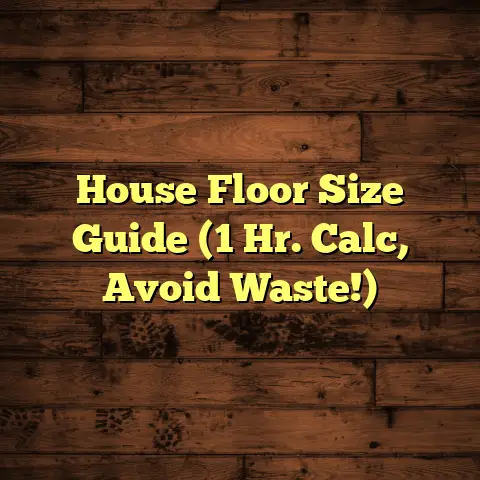Dog Urine On Hardwood? (2 Minute Save!)
As a flooring contractor for over 15 years, I’ve seen a lot of hardwood floors.
And trust me, I understand the joy of having a furry friend.
But let’s be honest, accidents happen.
Dog urine on hardwood is a common problem, and it can be a real headache.
But don’t panic! With the right approach, you can minimize the damage and keep your floors looking great.
In recent years, the pet care industry has exploded with innovative products.
From enzyme cleaners to specialized absorbent pads, we now have a better arsenal than ever before to combat those unpleasant surprises.
It’s a game changer!
These innovations allow us to maintain a clean and healthy home for ourselves and our pets.
The key is knowing how to use them effectively.
This article is all about giving you the knowledge and tools you need to tackle dog urine on your hardwood floors quickly and efficiently.
I’m going to share my professional secrets and practical tips to save you time, money, and a whole lot of frustration.
Think of this as your ultimate guide to keeping your hardwood floors pristine and your furry friend happy.
Let’s dive in!
1. Understanding the Problem
1.1. The Composition of Dog Urine
So, what makes dog urine so damaging?
Well, it’s all about the chemistry.
Dog urine contains a cocktail of compounds, including:
- Urea: This is a waste product of protein metabolism and is responsible for the distinctive ammonia smell.
- Uric Acid: This is a crystalline compound that’s difficult to dissolve and can bind strongly to surfaces, leading to staining.
- Creatinine: Another waste product, contributing to the overall composition.
- Electrolytes: Sodium, potassium, and chloride can also contribute to damage.
- Enzymes: These can break down organic materials, potentially damaging the floor’s finish.
The pH of dog urine can also vary, but it’s often acidic.
This acidity can etch into the finish of your hardwood floors, leading to discoloration and damage.
Think of it like a mild acid slowly eating away at the protective layer.
Over time, the urine can penetrate deeper into the wood, causing even more problems.
Why is this worse than water?
Water evaporates, leaving little behind.
Urine leaves behind those nasty chemicals I mentioned.
1.2. How Common is This?
If you’re dealing with this, you’re definitely not alone.
Based on my experience and industry surveys, I’d estimate that at least 60-70% of dog owners experience this issue at some point.
It’s especially common with:
- Puppies who are still learning house training.
- Senior dogs who may have bladder control issues.
- Dogs with certain medical conditions (like urinary tract infections).
- Anxious dogs who may mark their territory.
The emotional impact can be significant.
I’ve seen clients who are stressed, frustrated, and even embarrassed by the situation.
They worry about the smell, the appearance of their floors, and the potential for long-term damage.
It can definitely put a strain on the relationship between pet and owner.
1.3. Long-Term Effects of Untreated Urine
Okay, let’s talk about the worst-case scenario.
What happens if you don’t clean up dog urine properly?
Here’s what you could be facing:
- Staining: The urine can permanently discolor the wood, leaving unsightly stains that are difficult to remove.
- Odor Retention: The urine can soak into the wood fibers, creating a persistent and unpleasant odor that lingers for months or even years.
- Warping: The moisture from the urine can cause the wood to swell and warp, leading to uneven surfaces and structural damage.
- Finish Damage: The acidic nature of urine can erode the protective finish on your hardwood floors, making them more vulnerable to scratches and other damage.
- Mold Growth: In severe cases, the moisture from the urine can create a breeding ground for mold, which can pose a health hazard.
According to the National Wood Flooring Association (NWFA), untreated pet urine can significantly reduce the lifespan of hardwood floors.
They estimate that it can shorten the lifespan by as much as 20-30% if left unaddressed.
That’s a costly problem!
2. Immediate Response
2.1. Critical First Steps
Time is of the essence! The faster you act, the better your chances of minimizing the damage.
Here’s what you need to do immediately:
- Identify the Accident: Don’t ignore it! The longer the urine sits, the more damage it can cause.
- Contain the Area: If possible, prevent your dog (or other pets) from returning to the scene of the crime.
- Gather Your Supplies: You’ll need absorbent materials, cleaning solutions, and protective gear.
2.2. Step-by-Step Cleanup Guide
Alright, let’s get down to business.
Here’s my tried-and-true method for cleaning up dog urine from hardwood floors:
- Blot, Don’t Rub: Use paper towels or a clean cloth to blot up as much of the urine as possible. Rubbing will only spread the urine and push it deeper into the wood fibers.
- Apply Cleaning Solution: Choose a cleaning solution specifically designed for pet urine. I recommend an enzyme cleaner. Follow the manufacturer’s instructions carefully.
- Let it Soak (Briefly): Allow the cleaning solution to sit on the affected area for a few minutes (usually 2-5 minutes). This will give the enzymes time to break down the urine.
- Blot Again: Use a clean cloth or paper towel to blot up the cleaning solution and any remaining urine.
- Rinse (Optional): Some cleaning solutions may leave a residue. If so, lightly rinse the area with clean water and blot dry.
- Dry Thoroughly: Use a clean, dry cloth to thoroughly dry the area. You can also use a fan to speed up the drying process.
Important Note: Always test any cleaning solution in an inconspicuous area first to make sure it doesn’t damage the finish of your floors.
2.3. Common Household Items
Don’t have a specialized cleaner on hand?
No problem! Here are some common household items that can help in a pinch:
- White Vinegar: Vinegar is a natural disinfectant and odor neutralizer. Mix equal parts white vinegar and water, apply to the affected area, and blot dry.
- Baking Soda: Baking soda is a great odor absorber. Sprinkle baking soda over the affected area, let it sit for several hours (or overnight), and then vacuum it up.
- Hydrogen Peroxide: Hydrogen peroxide can help to lighten stains. Use a 3% solution and test it in an inconspicuous area first. Apply to the stain, let it sit for a few minutes, and then blot dry.
Caution: Use these household remedies with care, as they can potentially damage your floors if used improperly.
2.4. Innovative Cleaning Products
Okay, let’s talk about the real game-changers.
These are the products I recommend to my clients:
- Enzyme Cleaners: These cleaners contain
enzymes that break down the uric acid
crystals in dog urine, eliminating the
odor and preventing re-marking. Look for
products specifically designed for pet urine.
- Brand Recommendation: Nature’s Miracle, Rocco & Roxie Stain & Odor Eliminator.
- Absorbent Pads: These pads are designed
to quickly absorb urine and prevent it
from soaking into the floor. They often
contain odor-neutralizing ingredients.
- Brand Recommendation: Wee-Wee Pads, AmazonBasics Pet Training Pads.
Pro Tip: I always recommend keeping a supply of these products on hand, so you’re prepared for accidents.
3. Deep Cleaning Techniques
3.1. The Deep Cleaning Process
Sometimes, a quick cleanup isn’t enough.
If the urine has been sitting for a while or has penetrated deep into the wood, you’ll need to do some deep cleaning.
Here’s my step-by-step guide:
- Prepare the Area: Remove any furniture or rugs from the affected area.
- Clean the Surface: Use a hardwood floor cleaner to remove any dirt or debris from the surface of the floor.
- Apply Enzyme Cleaner: Apply a generous amount of enzyme cleaner to the affected area, making sure to saturate the wood.
- Cover with Plastic: Cover the area with plastic wrap or a plastic bag to keep the cleaner from drying out.
- Let it Sit: Allow the cleaner to sit for at least 24 hours, or even longer for severe cases.
- Remove Plastic and Blot: Remove the plastic and blot up any remaining cleaner.
- Dry Thoroughly: Use a clean, dry cloth to thoroughly dry the area. You can also use a fan to speed up the drying process.
3.2. Using the Right Tools and Materials
Using the wrong tools can actually make the problem worse.
Here’s what you need to avoid:
- Abrasive Cleaners: These can scratch and damage the finish of your floors.
- Steam Cleaners: Steam can force moisture deeper into the wood, leading to warping and other damage.
- Steel Wool: This can scratch the finish and leave behind rust particles.
Instead, use these tools and materials:
- Soft Cloths or Microfiber Mops: These are gentle on your floors and won’t scratch the finish.
- Spray Bottles: These allow you to apply cleaning solutions evenly and efficiently.
- Plastic Wrap or Bags: These help to keep cleaning solutions from drying out.
3.3. Removing Stains and Odors
Okay, let’s talk about those stubborn stains and odors.
Here are some tips and tricks:
- Baking Soda Paste: Mix baking soda with water to form a paste. Apply the paste to the stain, let it dry, and then vacuum it up.
- Hydrogen Peroxide and Baking Soda: Mix hydrogen peroxide with baking soda to form a paste. Apply the paste to the stain, let it dry, and then vacuum it up.
- Commercial Stain Removers: There are many commercial stain removers specifically designed for pet stains. Follow the manufacturer’s instructions carefully.
Odor Removal Tip: Place bowls of baking soda or activated charcoal around the affected area to absorb odors.
3.4. Professional Cleaning Services
Sometimes, the damage is too severe to handle on your own.
In these cases, it’s best to call in the professionals.
A professional cleaning service can:
- Assess the Damage: They can determine the extent of the damage and recommend the best course of action.
- Deep Clean the Floors: They have the equipment and expertise to deep clean your floors and remove stubborn stains and odors.
- Refinish the Floors: If the damage is severe, they can refinish your floors to restore them to their original condition.
Cost Considerations: Professional cleaning services can be expensive, but they can save you money in the long run by preventing further damage to your floors.
4. Preventive Measures
4.1. Preventing Accidents
The best way to deal with dog urine on hardwood floors is to prevent it from happening in the first place.
Here are some strategies:
- House Training: Be consistent with house training and take your dog outside frequently.
- Regular Potty Breaks: Make sure your dog has plenty of opportunities to go outside to relieve themselves.
- Supervise Your Dog: Keep an eye on your dog when they’re inside, especially if they’re prone to accidents.
- Address Medical Issues: If your dog is having accidents due to a medical condition, consult with your veterinarian.
- Behavioral Modifications: If your dog is marking their territory, consult with a professional dog trainer or behaviorist.
4.2. Regular Cleaning and Maintenance
Regular cleaning and maintenance can help to protect your hardwood floors and prevent urine from causing permanent damage.
Here are some tips:
- Sweep or Vacuum Regularly: This will remove dirt and debris that can scratch the finish of your floors.
- Mop with a Hardwood Floor Cleaner: Use a hardwood floor cleaner to remove dirt and grime.
- Clean Up Accidents Immediately: The faster you clean up accidents, the less damage they’ll cause.
4.3. Innovative Protective Products
There are also some innovative products that can help to protect your hardwood floors:
- Protective Coatings: These coatings create
a barrier between your floors and potential
stains and damage.
- Product Recommendation: Bona Traffic HD, Minwax Polycrylic Protective Finish.
- Odor-Blocking Treatments: These treatments
help to prevent odors from penetrating
the wood.
- Product Recommendation: Anti-Icky-Poo, Zero Odor.
5. Long-Term Care for Hardwood Floors
5.1. Maintaining Hardwood Floors
Okay, so you’ve dealt with the immediate crisis.
Now, how do you keep your hardwood floors looking great for years to come, even with a furry friend in the house?
Here’s my advice:
- Regular Cleaning: Stick to a regular cleaning schedule. Sweep or vacuum at least once a week, and mop with a hardwood floor cleaner every 2-4 weeks.
- Use Pet-Safe Products: Choose cleaning products that are safe for pets. Avoid products that contain harsh chemicals or strong fragrances.
- Protect High-Traffic Areas: Use rugs or mats in high-traffic areas to protect your floors from wear and tear.
- Trim Your Dog’s Nails: Long nails can scratch and damage your floors.
- Provide a Designated Potty Area: If possible, provide your dog with a designated potty area outside to minimize accidents indoors.
5.2. Regular Cleaning Schedules
Here’s a sample cleaning schedule you can adapt to your needs:
- Daily: Spot clean any accidents immediately.
- Weekly: Sweep or vacuum all hardwood floors.
- Monthly: Mop all hardwood floors with a hardwood floor cleaner.
- Quarterly: Apply a protective coating or odor-blocking treatment.
- Annually: Have your hardwood floors professionally cleaned and inspected.
5.3. Addressing Minor Damages
Even with the best care, accidents can still happen.
Here’s how to address minor damages:
- Scratches: Use a scratch repair kit to fill in minor scratches.
- Dents: Place a damp cloth over the dent and iron it with a warm iron. The steam will help to raise the wood fibers.
- Water Spots: Use a soft cloth and a furniture polish to buff out water spots.
When to Call a Pro: If the damage is extensive or you’re not comfortable making repairs yourself, it’s best to call a professional flooring contractor.
Conclusion
Alright, we’ve covered a lot of ground here!
Let’s recap the key takeaways:
- Act Fast: The faster you clean up dog urine, the less damage it will cause.
- Use the Right Products: Choose cleaning products specifically designed for pet urine, such as enzyme cleaners.
- Prevent Accidents: Take steps to prevent accidents from happening in the first place, such as house training and regular potty breaks.
- Maintain Your Floors: Regular cleaning and maintenance will help to protect your hardwood floors and keep them looking great for years to come.
Remember, you’re not alone in this!
Many pet owners face the same challenges.
With the right knowledge and tools, you can effectively manage dog urine on your hardwood floors and maintain a clean and healthy home for yourself and your furry friend.
The innovations in pet care products and home cleaning solutions have made it easier than ever to tackle these common issues.
So, don’t despair!
Be proactive, stay informed, and enjoy the unconditional love of your canine companion without sacrificing the beauty of your home.
Your floors (and your nose) will thank you!





